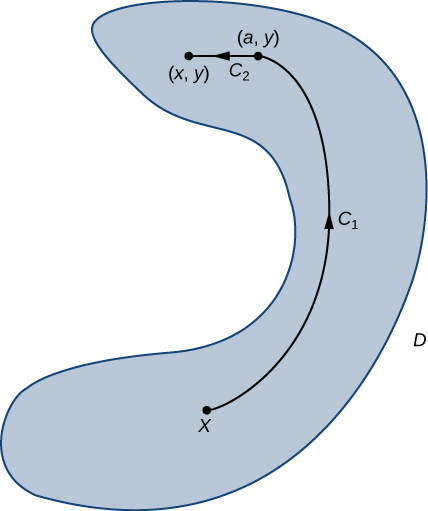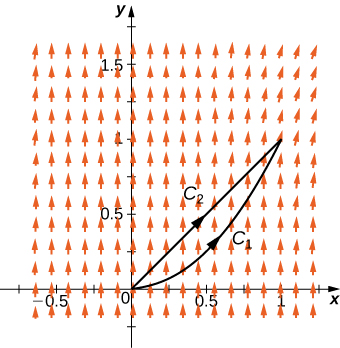| << Chapter < Page | Chapter >> Page > |
We prove the theorem for vector fields in The proof for vector fields in is similar. To show that is conservative, we must find a potential function for F . To that end, let X be a fixed point in D . For any point in D , let C be a path from X to Define by (Note that this definition of makes sense only because F is independent of path. If F was not independent of path, then it might be possible to find another path from X to such that and in such a case would not be a function.) We want to show that has the property
Since domain D is open, it is possible to find a disk centered at such that the disk is contained entirely inside D . Let with be a point in that disk. Let C be a path from X to that consists of two pieces: and The first piece, is any path from C to that stays inside D ; is the horizontal line segment from to ( [link] ). Then
The first integral does not depend on x , so
If we parameterize by then
By the Fundamental Theorem of Calculus (part 1),

A similar argument using a vertical line segment rather than a horizontal line segment shows that
Therefore and F is conservative.
□
We have spent a lot of time discussing and proving [link] and [link] , but we can summarize them simply: a vector field F on an open and connected domain is conservative if and only if it is independent of path. This is important to know because conservative vector fields are extremely important in applications, and these theorems give us a different way of viewing what it means to be conservative using path independence.
Use path independence to show that vector field is not conservative.
We can indicate that F is not conservative by showing that F is not path independent. We do so by giving two different paths, and that both start at and end at and yet
Let be the curve with parameterization and let be the curve with parameterization ( [link] ). Then
and
Since the value of a line integral of F depends on the path between two given points. Therefore, F is not independent of path, and F is not conservative.

Show that is not path independent by considering the line segment from to and the piece of the graph of that goes from to
If and represent the two curves, then
As we have learned, the Fundamental Theorem for Line Integrals says that if F is conservative, then calculating has two steps: first, find a potential function for F and, second, calculate where is the endpoint of C and is the starting point. To use this theorem for a conservative field F , we must be able to find a potential function for F . Therefore, we must answer the following question: Given a conservative vector field F , how do we find a function such that Before giving a general method for finding a potential function, let’s motivate the method with an example.

Notification Switch
Would you like to follow the 'Calculus volume 3' conversation and receive update notifications?